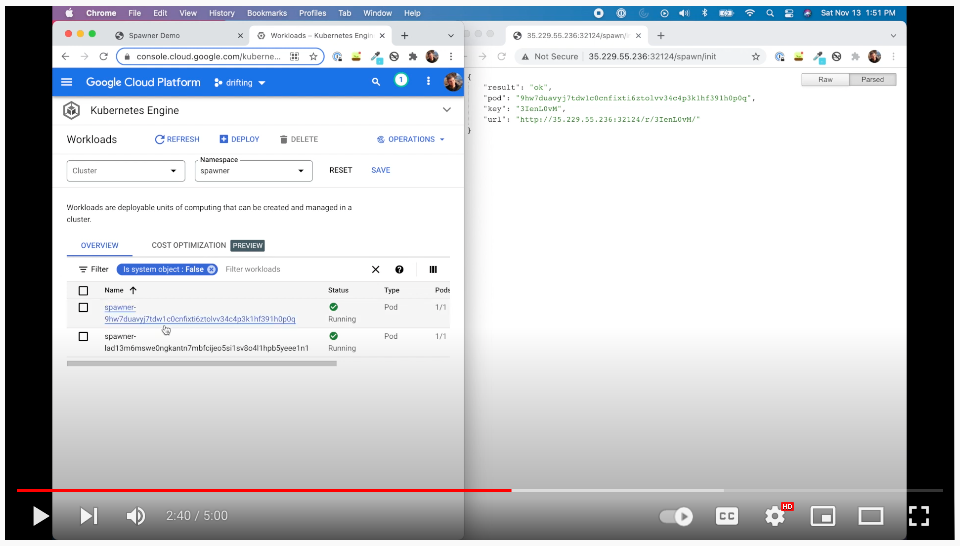Spawner is a bridge between a web application and Kuberenetes. It allows a web application to create session-lived containers that serve WebSocket or HTTP connections. Spawner coordinates with a reverse proxy, so that your client-side code can talk directly to these servers. session-lived means that when the remote client(s) close the connection, the container is cleaned up.
This is still a work-in-progress. It's demo-stage, and not ready for use in production just yet. If you are interested in being an early adopter, though, feel free to open an issue or email me at hi@driftingin.space.

Spawner is intended for cases where a web app needs a dedicated, stateful back-end to talk to for the duration of a session. One area where this approach is currently common is web-based IDEs like GitHub Codespaces, which spin up a container for each user to run code in. It's also useful as a back-end for real-time collaboration, when the document state is non-trivial and needs more than just a relay server (see e.g. Figma's description of how they run one process per active document.) By making it low-stakes to experiment with this architecture, my hope is that Spawner will help developers discover new use-cases, like loading a large dataset into system or GPU memory to allow real-time interactive data exploration.
Depending on your needs, it may also make sense as a back-end for games and virtual spaces, but also see Agones for that use case.
The Spawner process runs in a pod on your cluster and serves an HTTP API. On startup, it is passed an
--application-image argument that specifies the full path of the image for your application container
on a container registry.
When your web app wants to create a session-lived container, its backend sends a POST request to
http://hostname-of-spawner:8080/init. Spawner then asks Kubernetes to create a pod and service for that
session, and returns a JSON object containing a URL specific to that session-lived container, like
https://my-domain.com/p/JE3M/. This URL can then be passed on to the client-side container, which can
connect to it as a regular HTTP host. The proxy server is configured to map paths under the root,
so that https://my-domain.com/p/JE3M/my-file.txt is internally routed to
http://hostname-of-pod/my-file.txt.
Currently, Spawner works best with NGINX as a reverse proxy, but other reverse proxies with a similar feature set should also work. If there's a particular proxy you'd like to see supported, feel free to open an issue.
When Spawner detects that a container has not served a request for some (configurable) interval, it will shut down the pod and delete the service. It can determine whether a pod has served a request in one of two ways:
- The pod can serve a
/statusendpoint which returns aJSONblob that looks like this:
{
"active_connections": 2,
"seconds_inactive": 0,
"listening": true,
}active_connectionsis the number of active connections (e.g. WebSocket connections) to the server.seconds_inactiveis the amount of time elapsed since the last connection.listeningis true if the server is currently accepting new connections.
At least one of active_connections or seconds_inactive should be zero. Currently, only
seconds_inactive is used; the container is shut down when it passes a threshold value. Eventually,
the other values may be exposed through a monitoring interface.
- The sidecar process can be injected into your pod. The sidecar process shares a network
namespace with the application container, so it can ask the OS for active TCP connections on the
application container's port. It uses this information to serve the same
/statusinterface, but on a different port.
